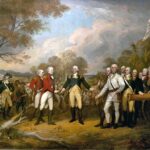
In his own time, Bouguereau was considered to be one of the greatest painters in the world by the academic art community, and simultaneously he was reviled by the avant-garde. He also gained wide fame in Belgium, the Netherlands, Portugal, Spain, Italy, Romania and in the United States, and commanded high prices.
His works often sold within days of completion. Some were viewed by international collectors and bought before work had even finished.
Bouguereau’s career was close to a direct ascent with hardly a setback. To many, he epitomized taste and refinement, and a respect for tradition. To others, he was a competent technician stuck in the past.
Degas and his associates used the term “Bouguereauté” in a derogatory manner to describe any artistic style reliant on “slick and artificial surfaces”, also known as a licked finish.
Looked Down on by Impressionists?
In an 1872 letter, Degas wrote that he strove to emulate Bouguereau’s ordered and productive working style, although with Degas’ famous trenchant wit, and the aesthetic tendencies of the Impressionists, it is possible the statement was meant to be ironic.
Paul Gauguin loathed him, rating him around zero in Racontars de Rapin and later describing in Avant et après (Intimate Journals) the single occasion when Bouguereau made him smile on coming across a couple of his paintings in an Arles’ brothel, “where they belonged.
Bouguereau’s works were eagerly bought by American millionaires who considered him the most important French artist of that time.
For example, Nymphs and Satyr was purchased first by John Wolfe, then sold by his heiress Catharine Lorillard Wolfe to hotelier Edward Stokes, who displayed it in New York City’s Hoffman House Hotel.
But even during his lifetime there was critical dissent in assessing his work; the art historian Richard Muther wrote in 1894 that Bouguereau was a man “destitute of artistic feeling but possessing a cultured taste [who] reveals… in his feeble mawkishness, the fatal decline of the old schools of convention.”
In 1926, American art historian Frank Jewett Mather criticized the commercial intent of Bouguereau’s work, writing that the artist “multiplied vague, pink effigies of nymphs, occasionally draped them, when they became saints and madonnas, painted on the great scale that dominates an exhibition, and has had his reward.
I am convinced that the nude of Bouguereau was prearranged to meet the ideals of a New York stockbroker of the black walnut generation.” Bouguereau confessed in 1891 that the direction of his mature work was largely a response to the marketplace: “What do you expect, you have to follow public taste, and the public only buys what it likes. That’s why, with time, I changed my way of painting.”
Loss of Popularity: The Art World’s Shame
Bouguereau fell into disrepute after 1920, due in part to changing tastes. Comparing his work to that of his Realist and Impressionist contemporaries, Kenneth Clark faulted Bouguereau’s painting for “lubricity”, and characterized such Salon art as superficial, employing the “convention of smoothed-out form and waxen surface.”
The New York Cultural Center staged a show of Bouguereau’s work in 1974—partly as a curiosity, although curator Robert Isaacson had his eye on the long-term rehabilitation of Bouguereau’s legacy and reputation.
In 1984, the Borghi Gallery hosted a commercial show of 23 oil paintings and one drawing. In the same year, a major exhibition was organized by the Montreal Museum of Fine Arts in Canada.
The exhibition opened at the Musée du Petit-Palais, in Paris, traveled to The Wadsworth Atheneum in Hartford, and concluded in Montréal. More recently, a resurgence in the artist’s popularity has been promoted by American collector Fred Ross, who owns a number of paintings by Bouguereau and features him on his website at Art Renewal Center.
In 2019, the Milwaukee Art Museum assembled more than 40 of Bouguereau’s paintings for a major retrospective of his work, which according to the Wall Street Journal, asked the readers to “see Bouguereau through the eyes of an age when he was lionized, and Impressionism was dismissed as ‘French freedom.’
The exhibition later was scheduled to travel to the Memphis Brooks Museum of Art in Memphis, Tenn., and then to the San Diego Museum of Art. Source: Wikipedia.




